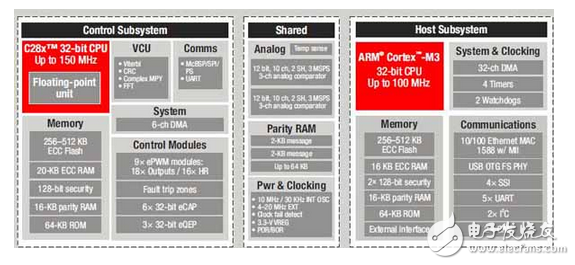
资料下载

多核微控制器提供新的嵌入式期权
多核微控制器提供新的嵌入式期权
嵌入式系统设计者面临着不断增长的性能需求和更快的市场需求。嵌入式处理器需要执行扩展的任务集,通常是实时的。同时,应用要求高吞吐量和节能,加上外形小、成本低。多核微控制器单元(MCU)提供了一个可行的新的解决方案,利用模块化设计,以经济的价格提供多种性能的提高。
几十年来,随着集成电路晶体管数量的增加,芯片性能保持同步。越来越先进的架构,包括缓存和流水线技术,使芯片设计者能够利用不断增长的硅密度来不断提高处理速度。那不再是事实了。芯片设计者已经用尽了替代体系结构的可能性。生产力的跳跃已经从穆尔定律的速度下降到不到一半。提高生产率的唯一方法是通过使用多个CPU来提高模块化率。这导致了多核微控制器的发展。

Hardware: homogeneous versus heterogeneous
We define a multicore MCU as a microprocessor featuring two or more CPUs that coherently share a common memory. In the multicore architecture, each processor features its own instruction stream acting on its own data stream (MIMD)。
Multicore MCUs can be classed as homogeneous or heterogeneous. As the name suggests, homogeneous modules feature two identical CPUs that can run operations in parallel or redundantly. Designed for safety applications, the Hercules line fromTexas Instruments boasts dual ARM Cortex-R4F CPUs running in lockstep. They perform the same operation, then compare the results each clock cycle, effectively establishing a “safe island” that provides designers with a reliable foundation to implement more sophisticated operations in medical, industrial, and automotive applications. To remove potential common failure modes, the design team oriented the chipset 90° to one another and introduced a delay in the timing of the processors. The chip can operate at up to 200 MHz and sports 32 Mbytes of flash memory.
声明:本文内容及配图由入驻作者撰写或者入驻合作网站授权转载。文章观点仅代表作者本人,不代表电子发烧友网立场。文章及其配图仅供工程师学习之用,如有内容侵权或者其他违规问题,请联系本站处理。 举报投诉
- 相关下载
- 相关文章





